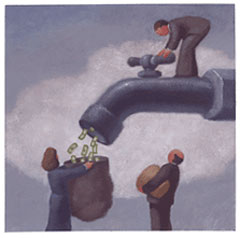Despite all the focus on procurement over the past decade, most companies are still missing major opportunities to reduce spending, a trio of Bain & Company consultants say.
Writing a guest column on the IndustryWeek web site, David Schannon, Sam Thakararand and Klaus Neuhaus say that outside spend generally represents a substantial component of a company's cost, averaging 43% across all sectors, but even more in industries such as semiconductors (60%), chemicals (56%) and electronics (53%).
Supply Chain Digest Says... |
 |
| Spending better focuses on what companies are buying, not just what they pay for it, and can produce 60% of total savings. |
 |
What do you say? |
| Click here to send us your comments |
 |
| Click here to see reader feedback |
|
|
As such, there is tremendous financial leverage from improvements in procurement effectiveness.
That's hardly new insight, but the Bain consultants quantify the potential, saying world class procurement organizations reduce a company's purchasing cost base by an average of 8%-12% and deliver additional annual savings of 2%-3%.
They have recommendations about how to get there, but first SCDigest liked Bain's insight on the disconnect found in many if not the vast majority of companies: procurement annually claims a substantial amount of savings from its efforts - yet the CEO and the CFO can't seem to find how those savings made their way to the bottom line.
First, Bain says many procurement based savings cross the budgets of several business units, and in effect get lost in the financial translation. It therefore recommends better collaboration between procurement and finance, so that "they can create systems that reliably capture these gains, delivering real cash savings to management."
But even more interesting on this topic, here is what else Bain says commonly occurs: "Procurement generates savings at the category level, but business-unit managers spend at the budget level. Since most companies don't have transparent systems that map categories to budgets, managers often take savings from one category and spend them elsewhere."
But when managers spend their entire budget, "procurement savings quietly disappear. By that time, procurement teams already have reported the gains to finance and moved on to the next initiative."
Bain says leading companies close this loop by connecting procurement and finance to make sure category-level savings flow into the current year's budget. In other words, if real savings are achieved, current budgets are reduced accordingly, locking in the gains.
Buying and Spending Better
Bain says most companies focus on buying better, through such techniques as negotiations and supplier selection processes.
(See More Below)
|
CATEGORY SPONSOR: SOFTEON |
|
|
| |
|
|
 That's important, Bain says, but spending better can actually double the financial results of buying better. Spending better focuses on what companies are buying, not just what they pay for it, and can produce 60% of total savings. That's important, Bain says, but spending better can actually double the financial results of buying better. Spending better focuses on what companies are buying, not just what they pay for it, and can produce 60% of total savings.
Bain offers three guidelines for spending better:
Get a grip on demand: Leading companies streamline purchasing. By examining specific categories, procurement teams can put a spotlight on unnecessary spending.
Design to cost: World-class purchasing teams also make sure design teams are not over-engineering new products. They embed procurement managers in the R&D team to assess the cost of different components and consider alternative options that may be more cost-effective.
Reduce system costs: Successful companies evaluate the total cost of owning expensive items. Paying more upfront can be the more economical choice if savings over time outweigh an initial higher cost. They examine their supply chain to understand whether it makes more sense to produce items in-house or buy them from someone else. And they work with suppliers to reduce supplier complexity and bring costs down.
Finally, Bain says companies must invest in their procurement organizations to sustain gains year after year.
That include creating a more strategic role for procurement, which "helps companies invest in and attract talented people whose capabilities are critical to sustaining behavior change" that will create competitive advantage over time," the authors say.
"By bringing procurement into the routine process of decision-making, the entire leadership team is more attuned to opportunities to liberate cash that can be invested in growth," Bain concludes. "That, in turn, helps companies put the right organization in place to deliver savings that stick."
What is your reaction to these observations and recommendations from Bain? Do you agree claimed savings from procurement are generally hard to find on the bottom line? Let us know your thoughts at the Feedback section below.
Your Comments/Feedback
|
|
Ed Elsbury
Associate Partner, Reveal |
Posted on: Mar, 11 2017 |
|
| The final observation, investing in procurement organizations, is a key part of improving effectiveness. Buyers often have not been educated on the reports and analytics available in the ERP systems they are using. Leveraging these tools to improve buyng decisions and automate processes can often lead to sustainable savings of more than 15% without any further investments in new technology. |
|
|